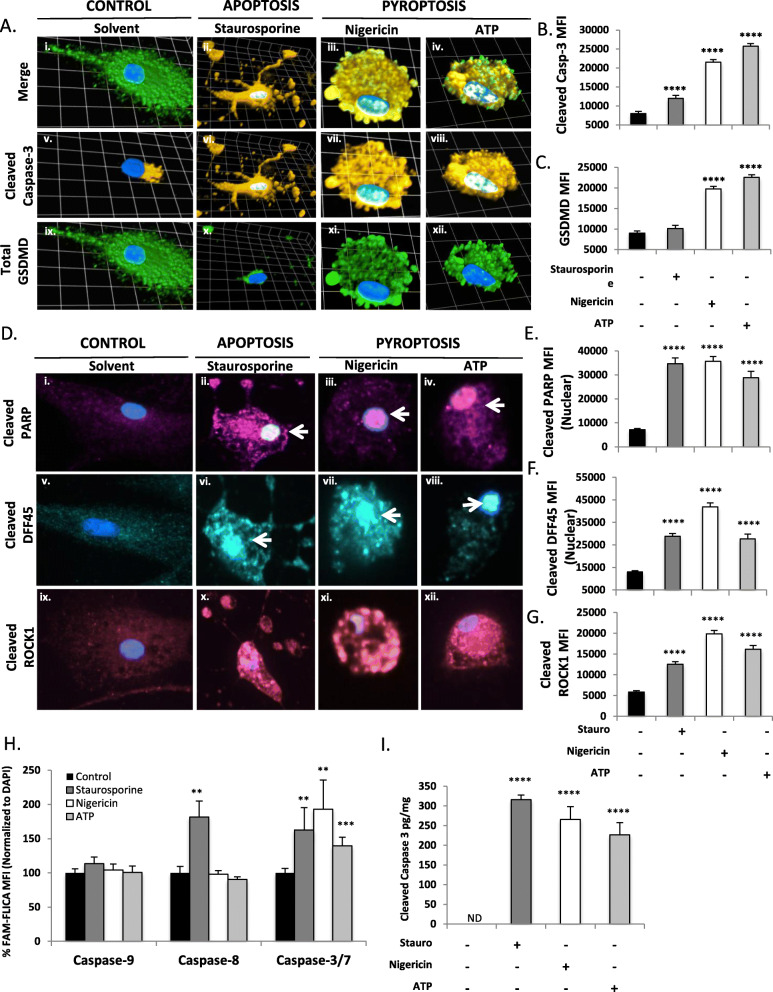Fig. 4.
Caspase-3 and its substrates are cleaved during pyroptosis in microglia. Primary human microglia were exposed to the pro-pyroptotic stimuli ATP (100.0 μM, 24 h) or nigericin (5.0 μM, 4 h), the pro-apoptotic stimulus staurosporine (5.0 μM, 4 h), or vehicle [equivalent volume PBS (24 h)]. Cells were fixed and immunolabelled for cleaved caspase-3 p17/p19 (Av–viii, amber) and total GSDMD (Aix–-xii, green), merge shown in (Ai–iv), and visualized by confocal microscopy. Images represent three-dimensional z-stacks incorporating 15 XY planes over a vertical distance of 4–6 μm. One square unit represents 10.28 μm. Human microglia immunolabelled for cleaved caspase-3 p17/p19 (b) and GSDMD (c) were visualized using confocal microscopy. Mean fluorescence intensity (MFI) of each protein was assessed for a minimum of n = 40 microglia per condition. Data shown represent mean MFI ± SEM for a representative human donor. These data were recapitulated in microglia from three separate human donors. Microglia were similarly exposed to staurosporine (5 μM, 4 h), nigericin (5 μM, 4 h), or ATP (100 μM, 24 h), fixed, and immunolabelled for cleaved PARP (Di–iv, magenta), cleaved DFF45 (Dv–viii, cyan), or cleaved ROCK1 (Dix–xii, pink). Representative two-dimensional images shown (nuclei indicated by white arrows). Nuclear mean fluorescence intensity (MFI) of cleaved PARP (c) and cleaved DFF45 (d) was assessed (n = 10–20 cells per condition). Total MFI for cleaved ROCK1 was also assessed (g). Microglia in stage 0 were excluded from analysis. Data shown represent mean MFI ±- SEM for a representative human donor. Data were tested for significance using one-way ANOVA with Dunnett’s test for multiple comparisons (****p < 0.0001). To identify caspase activation following pyroptotic or apoptotic stimuli, microglia were exposed to ATP (100.0 μM, 24 h), nigericin (5.0 μM, 4 h), and staurosporine (1 μM, 4 h) and caspase-9, -8 and -3/7 activity was assessed using activity-dependent caspase fluorescent probes and normalized to DAPI (h). Microglia were exposed to pyroptotic stimuli ATP (100.0 μM, 24 h) or nigericin (5.0 μM, 4 h), from which lysates were harvested and cleaved caspase-3 levels assessed by ELISA (i). Staurosporine exposure (1 μM, 4 h) was utilized as a positive control for caspase-3-activation. Data shown represent mean cleaved caspase-3 levels ± SEM (n = 6 technical replicates) from a representative human donor. Results were confirmed in microglia from 3 to 5 donors

